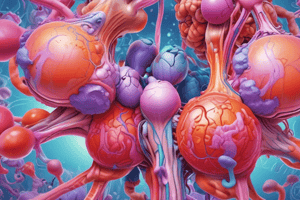Podcast
Questions and Answers
What is gluconeogenesis?
What is gluconeogenesis?
- The breakdown of glucose to produce energy.
- The creation of new sugar in the liver. (correct)
- The synthesis of glycogen from glucose.
- The release of glucose from glycogen.
Which test measures glucose levels several hours after eating?
Which test measures glucose levels several hours after eating?
- Oral Glucose Tolerance Test
- Fasting Blood Glucose test
- HbA1C test
- Postprandial Glucose test (correct)
What is a characteristic feature of Type 1 diabetes?
What is a characteristic feature of Type 1 diabetes?
- Insulin deficiency due to autoimmune destruction. (correct)
- Higher insulin production over time.
- Development during pregnancy.
- Insulin resistance.
How does parathyroid hormone contribute to calcium homeostasis?
How does parathyroid hormone contribute to calcium homeostasis?
What effect does hyperinsulinism have on blood sugar levels?
What effect does hyperinsulinism have on blood sugar levels?
Which of the following is NOT a potential complication of diabetes?
Which of the following is NOT a potential complication of diabetes?
What is the function of calcitonin in calcium regulation?
What is the function of calcitonin in calcium regulation?
Which hormone is primarily responsible for insulin resistance seen in Type 2 diabetes?
Which hormone is primarily responsible for insulin resistance seen in Type 2 diabetes?
Which hormone is NOT produced by the pituitary gland?
Which hormone is NOT produced by the pituitary gland?
What is the primary role of parathyroid hormone (PTH)?
What is the primary role of parathyroid hormone (PTH)?
Which of the following is a characteristic of lipid-soluble hormones?
Which of the following is a characteristic of lipid-soluble hormones?
What condition is characterized by excessive calcium in the blood?
What condition is characterized by excessive calcium in the blood?
In negative feedback regulation, which two hormones are directly related when dealing with thyroxine levels?
In negative feedback regulation, which two hormones are directly related when dealing with thyroxine levels?
Which condition is characterized by excessive thyroid hormone production?
Which condition is characterized by excessive thyroid hormone production?
Which hormone stimulates the expulsion of milk from the mammary glands?
Which hormone stimulates the expulsion of milk from the mammary glands?
What is the primary function of glucagon in the body?
What is the primary function of glucagon in the body?
What is a common cause of hypocalcemia?
What is a common cause of hypocalcemia?
What effect does prolactin have during breastfeeding?
What effect does prolactin have during breastfeeding?
Which of the following hormones is secreted by the adrenal medulla?
Which of the following hormones is secreted by the adrenal medulla?
Which of the following is a symptom of hypercortisolism (Cushing disease)?
Which of the following is a symptom of hypercortisolism (Cushing disease)?
Which hormone is primarily involved in childbirth and lactation through positive feedback?
Which hormone is primarily involved in childbirth and lactation through positive feedback?
What happens to blood glucose levels when insulin is released?
What happens to blood glucose levels when insulin is released?
What is one consequence of hypoinsulinism?
What is one consequence of hypoinsulinism?
How does oxytocin contribute to childbirth?
How does oxytocin contribute to childbirth?
Flashcards are hidden until you start studying
Study Notes
Endocrine Glands and Their Products
- Pituitary Gland: Produces growth hormone, TSH, ACTH, LH, FSH, prolactin, ADH, and oxytocin.
- Thyroid Gland: Secretes thyroxine (T4), triiodothyronine (T3), and calcitonin.
- Parathyroid Glands: Release parathyroid hormone (PTH).
- Adrenal Glands: Cortex produces cortisol, aldosterone, androgens; medulla produces epinephrine and norepinephrine.
- Pancreas: Produces insulin, glucagon, and somatostatin.
- Gonads: Ovaries produce estrogens and progesterone; testes produce testosterone.
- Pineal Gland: Secretes melatonin.
- Thymus: Produces thymosin.
Hormone Solubility
- Water-soluble Hormones: Bind to plasma membrane receptors.
- Lipid-soluble Hormones: Pass through plasma membrane to bind with internal receptors.
Hormonal Regulation
- Negative Feedback: Reduces hormone levels to maintain balance (e.g., thyroxine-TSH-TRH relationship).
- Positive Feedback: Amplifies responses for specific outcomes (e.g., oxytocin release during childbirth).
Thyroid Disorders
- Hypothyroidism: Low thyroid hormone production; symptoms include cold intolerance, weight gain, slow heart rate.
- Hyperthyroidism: Excessive thyroid hormone production; symptoms include weight loss, heat intolerance, and rapid heart rate.
Calcium Disorders
- Hypocalcemia: Low blood calcium; symptoms may arise from Vitamin D deficiency or parathyroid gland issues.
- Hypercalcemia: High blood calcium; caused by enlarged parathyroid glands or hormonal imbalances.
Cushing's Syndrome
- Hypercortisolism: Excess cortisol; signs include weight gain, hypertension, and pupil dilation.
Maternal Milk Delivery
- Oxytocin: Stimulates uterine contractions and milk ejection; produced in hypothalamus.
- Prolactin: Responsible for milk production; inhibited during breastfeeding due to hormone changes.
Glucose Regulation
- Glucagon: Released by alpha cells in low glucose scenarios; stimulates glycogenolysis and gluconeogenesis.
- Insulin: Released by beta cells in response to high glucose; facilitates glucose uptake and glycogen synthesis.
Metabolic Processes
- Gluconeogenesis: Production of glucose from non-carbohydrate sources.
- Glycogenolysis: Breakdown of glycogen into glucose.
- Glycogen Synthesis: Formation of glycogen from glucose.
- Glycolysis: Breakdown of glucose for energy.
Glucose Measurement Techniques
- Fasting Blood Glucose Test
- Oral Glucose Tolerance Test
- HbA1C Test
- Postprandial Glucose Test
Hyperinsulinism
- Excess insulin can lead to hypoglycemia due to increased glucose uptake by cells.
Diabetes Types
- Type 1 Diabetes: Autoimmune destruction of beta cells; leads to little to no insulin production.
- Type 2 Diabetes: Insulin resistance in cells; pancreas fails to produce adequate insulin over time.
- Gestational Diabetes: Diabetes during pregnancy; usually resolves post-delivery, caused by placental hormones.
Diabetes Impact
- Increased risk of heart disease, neuropathy, kidney damage, retinopathy, infections, poor circulation, sexual dysfunction, and weakened immune response.
Calcium Homeostasis Regulation
- Calcitonin: Lowers blood calcium by reducing bone resorption and promoting excretion.
- Parathyroid Hormone (PTH): Raises blood calcium by increasing bone resorption and reducing urinary calcium loss.
- Vitamin D: Enhances calcium absorption and balances calcium in the blood.
Studying That Suits You
Use AI to generate personalized quizzes and flashcards to suit your learning preferences.




